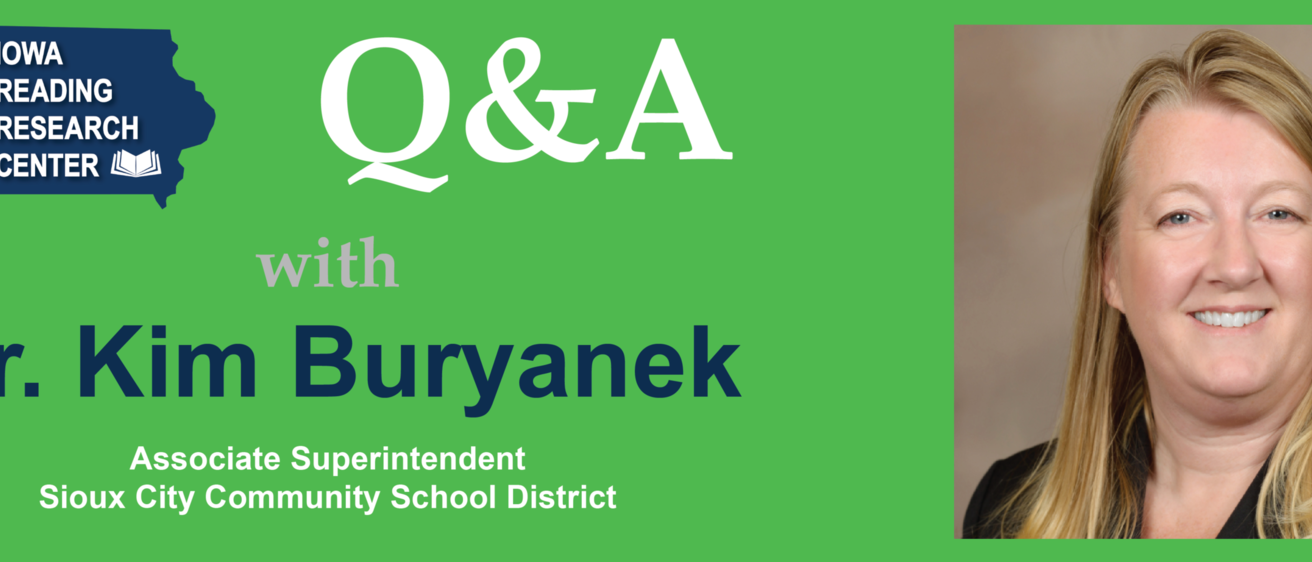783 words | 4 minute read
Director’s Note: In our last blog post, we discussed the ongoing process of implementing small-group, skills-based literacy instruction in elementary schools in the Sioux City Community School District with Associate Superintendent Kim Buryanek*. She told us some of the positive outcomes she observed in the classroom as a result of the implementation and expanded on a couple of elements that were critical to the implementation process. We are fortunate to have Buryanek answer a few more questions about this process. I think schools and districts considering a similar literacy instruction approach may benefit from hearing about Kim and the district’s experiences and plans moving forward.
This is the fourth of a multi-part series of Q&A posts with Sioux City Community School District faculty on the implementation of small-group, skills-based literacy instruction in elementary schools.
Deborah K. Reed, Ph.D.
Director, Iowa Reading Research Center
*Buryanek is also chair of the Iowa Reading Research Center Advisory Council.
Q: How did you help the district and schools keep their focus on this literacy initiative?
Kim Buryanek (KB): During the 2016-2017 school year, all administrators in the district learned about McREL’s Balanced Leadership Framework, and principals were applying the balanced leadership components to small-group, skills-based instruction. One key component of the Balanced Leadership Framework is focus. For the 2017-2018 school year, the goal for each of the elementary buildings is to increase the CBM-Reading (curriculum-based measurement for reading) composite score on the FAST (Formative Assessment System for Teachers) assessment by 10% from fall to spring. The elementary principals have worked with their building leadership teams and created a plan to achieve that goal. Every elementary building has small-group, skills-based instruction embedded in their plan and has identified a timeline by which to simultaneously accomplish the goal and successfully implement small-group, skills-based instruction.
The practice of conducting instructional rounds also provided focus on the literacy initiative. Dr. Tim Grieves, Northwest Area Education Agency chief administrator, provided us with training on how to conduct instructional rounds. Instructional rounds, started by Harvard Graduate School of Education Professor Dr. Richard Elmore, are a process to build knowledge and skills of participants and to provide helpful feedback to the host school. Sioux City Community School District Director of Elementary Education Brian Burnight then scheduled and facilitated instructional rounds with the problem of practice [i.e., the focus of the instructional rounds] being small-group, skills-based instruction for the schools implementing the change. Building leaders received valuable feedback from their peers that helped shape professional development and caused the initiative to move to the next level of implementation.
Q: What are the next steps you will be taking in your implementation of small-group, skills-based literacy instruction?
The remaining elementary schools received the new literacy materials [being used for the implementation] this summer. All elementary schools will be implementing small-group, skills-based instruction this year, and support for both new and initial implementers will be provided.
The alignment of resources to student skill needs will continue. We will utilize technology to develop a repository for grade-level and skill-level resources that all teachers can access. Our best practices will be shared internally.
Time was spent this spring and summer developing a fidelity or walkthrough tool for administrators to use when observing teachers during the literacy block. We began using the tool in September. As administrators collect data during walkthroughs, we will be able to identify areas for increased support through professional development.
We also plan to capture best practices or exemplars through videos that we will be able to use across the district for professional development. We will assemble a team this fall to identify the components within the literacy block that are most important and then make videos of teachers demonstrating best practices in delivering those components. The videos will be available for building leaders to use for professional development, for individual teachers to use for personal development, and for teacher leaders to use for coaching cycles.
Q: How will you know when your efforts have been successful?
We will use data to indicate the success of our efforts. We want to see an increase in the percent of elementary students who score at or above the benchmark on the FAST screener.
We have an intervention/enrichment period at all the middle schools in the district. Students that are scheduled into the intervention period receive instruction in reading skills. We want to see a decrease in the number of students that are assigned to the decoding skills intervention period at the middle schools.
Furthermore, we want to see increased consistency in literacy instruction across elementary classrooms and buildings. Evidence of increased consistency will be retrieved from walkthrough data, instructional rounds, and routine classroom observations.
